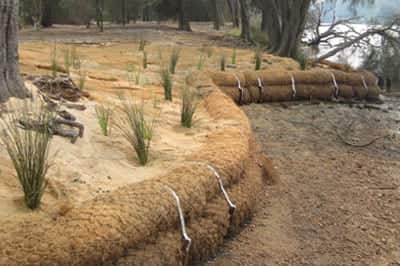How do Coir Logs Help With Erosion Control?

Coir is a natural fibre that comes from coconut husk, and it’s one of the core materials in ship ropes because of its strength, durability and resistance to water damage. It is now commonly used for erosion control by placing coir logs on the banks of water bodies. Coir logs are an excellent tool for restricting erosion while allowing the environment to flourish and stabilise the ground.
Ecospill stock coir logs that allow vegetation to grow through them and biodegrade at the end of their service life. In this article, we explain what a coir log is and how it helps with erosion control.
WHAT EXACTLY IS A COIR LOG?
A coir log is a product made of coir fibres rolled into a log shape for easy manoeuvring and placement. Coir logs are excellent devices to stabilise banks, wetlands and construction sites as they minimise erosion. Compared to rocks or bulkheads, coir logs allow vegetation to grow within them. As they slowly biodegrade into their environment, they become part of the soil that supports vegetation growth.
Coir logs consist of dense coil fibres wrapped in a woven coir mesh, which are entirely natural and biodegradable. They’re also low-cost and durable, which means they do an outstanding job at controlling erosion and can remain in place until they stabilise into the ground. These features make these erosion control logs perfect for vulnerable river banks, areas where remedial works have taken place and where vegetation has been lost.
HOW DO COIR LOGS HELP WITH EROSION CONTROL?
Below we look at the three powerful ways that coir logs protect banks from erosion:
Absorbs wave power
The power of waves causes erosion by weakening shorelines and soil and dispersing sediments. When you place these erosion control logs on water banks, they’re in a position to absorb the power of waves so that after the wave hits the log, there is minimal power to damage river and lake banks. You should install coir logs in areas with loose soils that waves can easily sweep away. Their impact on reducing wave power means that these soils can remain in place, and the power of waves won’t impact the structure of the shore.
Allows vegetation
Coir logs are unique because they allow vegetation to grow within them. This is important to erosion control because the roots of vegetation stabilise the soil. Stabilised soil is much stronger and becomes less impacted by erosion and the power of waves. Additionally, the plants within these erosion control logs trap sediments and dirt in suspension from water flow, which quickly refill eroded pockets and restrengthen the bank behind the coir log. Coir logs allow the bank to revegetate while they’re in place, protecting the area so it can go on to defend itself once the log degrades.
Strengthens the soil
Another feature of these erosion control logs is that they eventually biodegrade into the soil. The remaining fibres of the log root into the ground and soil, providing an extra root system to stabilise the bank. You can leave these erosion logs to their own devices, as leaving them will have an ongoing benefit to controlling erosion on vulnerable banks.
SUMMARY
Coir logs protect banks from erosion in three excellent ways throughout their entire lifecycle. They absorb the power of waves to reduce the damage water does to banks immediately. Over time the vegetation’s roots stabilise the ground, facilitated by coir logs. Finally, when these logs biodegrade, the remaining fibres root into the ground to strengthen to land into the future. Ecospill stock 100 percent natural and biodegradable coir logs to support the protection of vulnerable banks. Contact us to discuss if coir logs will be suitable for your needs.
